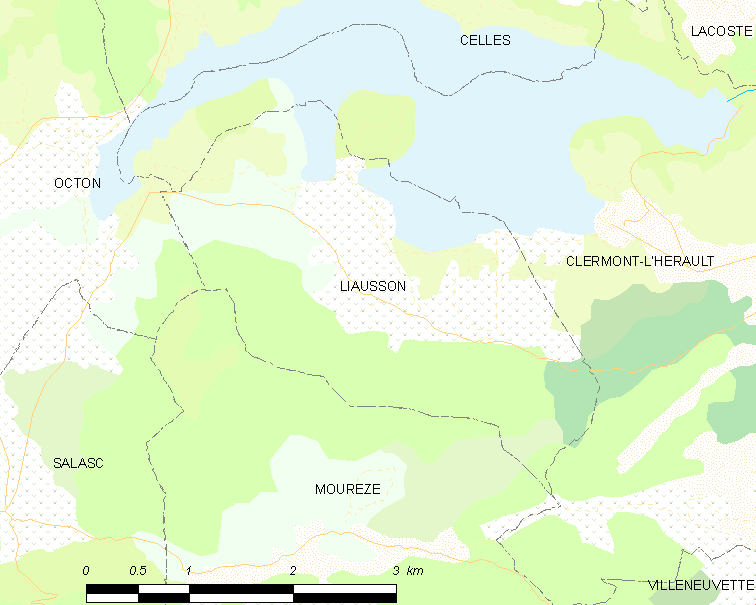|
Villeneuvette
Villeneuvette (; oc, La Fatura) is a commune in the Hérault department in the Occitanie region in southern France. It is close to the town of Clermont l'Hérault. Villeneuvette is a small village made up of a group of buildings built in the 17th century to create a royal clothmaking factory and to provide accommodation for its workers. Apart from a hotel and restaurant, the buildings are now restricted to residential use, many for holiday purposes. The creation of Villeneuvette was promoted in 1677 by Jean-Baptiste Colbert, the noted finance minister of King Louis XIV. It was one of his many initiatives to develop France's industrial base. The factory was powered hydraulically, the water being drawn from various water courses from existing basins. The factory was privately owned and produced cloth for the king, including uniforms for his armies. The factory was operational until 1955. Since 1995, the village has been classified as a "''Zone de Protection du Patrimoine et du Pays ... [...More Info...] [...Related Items...] OR: [Wikipedia] [Google] [Baidu] |
Liausson From Villeneuvette, Hérault 01
Liausson () is a commune in the Hérault département in the Occitanie Occitanie may refer to: *Occitania, a region in southern France called ''Occitanie'' in French *Occitania (administrative region) Occitania ( ; french: Occitanie ; oc, Occitània ; ca, Occitània ) is the southernmost administrative region of ... region in southern France. Population Sights The church was built on the ruined foundations of a Roman villa Gallery File:Liausson, Hérault, Town Hall 01.jpg, La mairie. File:Liausson, Hérault, lavoir 01.jpg, Le lavoir. File:Liausson, Hérault 01.jpg, Dawn on the village. File:Liausson from Villeneuvette, Hérault 01.jpg, "Montagne de Liausson" from Villeneuvette. See also * Communes of the Hérault department References Communes of Hérault {{Hérault-geo-stub ... [...More Info...] [...Related Items...] OR: [Wikipedia] [Google] [Baidu] |
Communes Of The Hérault Department
The following is a list of the 342 communes of the Hérault department of France. The communes cooperate in the following intercommunalities (as of 2020):BANATIC Périmètre des EPCI à fiscalité propre. Accessed 3 July 2020. * * * |
Communes Of France
The () is a level of administrative division in the French Republic. French are analogous to civil townships and incorporated municipalities in the United States and Canada, ' in Germany, ' in Italy, or ' in Spain. The United Kingdom's equivalent are civil parishes, although some areas, particularly urban areas, are unparished. are based on historical geographic communities or villages and are vested with significant powers to manage the populations and land of the geographic area covered. The are the fourth-level administrative divisions of France. vary widely in size and area, from large sprawling cities with millions of inhabitants like Paris, to small hamlets with only a handful of inhabitants. typically are based on pre-existing villages and facilitate local governance. All have names, but not all named geographic areas or groups of people residing together are ( or ), the difference residing in the lack of administrative powers. Except for the municipal arrondi ... [...More Info...] [...Related Items...] OR: [Wikipedia] [Google] [Baidu] |
Hérault
Hérault (; oc, Erau, ) is a department of the region of Occitania, Southern France. Named after the Hérault River, its prefecture is Montpellier. It had a population of 1,175,623 in 2019.Populations légales 2019: 34 Hérault INSEE History [...More Info...] [...Related Items...] OR: [Wikipedia] [Google] [Baidu] |
Departments Of France
In the administrative divisions of France, the department (french: département, ) is one of the three levels of government under the national level ("territorial collectivities"), between the administrative regions and the communes. Ninety-six departments are in metropolitan France, and five are overseas departments, which are also classified as overseas regions. Departments are further subdivided into 332 arrondissements, and these are divided into cantons. The last two levels of government have no autonomy; they are the basis of local organisation of police, fire departments and, sometimes, administration of elections. Each department is administered by an elected body called a departmental council ( ing. lur.. From 1800 to April 2015, these were called general councils ( ing. lur.. Each council has a president. Their main areas of responsibility include the management of a number of social and welfare allowances, of junior high school () buildings and technical staff, ... [...More Info...] [...Related Items...] OR: [Wikipedia] [Google] [Baidu] |
Occitania (administrative Region)
Occitania ( ; french: Occitanie ; oc, Occitània ; ca, Occitània ) is the southernmost administrative region of metropolitan France excluding Corsica, created on 1 January 2016 from the former regions of Languedoc-Roussillon and Midi-Pyrénées. The Council of State approved Occitania as the new name of the region on 28 September 2016, coming into effect on 30 September 2016. The modern administrative region is named after the larger cultural and historical region of Occitania, which corresponds with the southern third of France. The region of Occitania as it is today covers a territory similar to that ruled by the Counts of Toulouse in the 12th and 13th centuries. The banner of arms of the Counts of Toulouse, known colloquially as the Occitan cross, is used by the modern region and is also a popular cultural symbol. In 2015, Occitania had a population of 5,839,867. Toponymy Enacted in 2014, the territorial reform of French regions had been subject to debate for many years. ... [...More Info...] [...Related Items...] OR: [Wikipedia] [Google] [Baidu] |
Regions Of France
France is divided into eighteen administrative regions (french: régions, singular ), of which thirteen are located in metropolitan France (in Europe), while the other five are overseas regions (not to be confused with the overseas collectivities, which have a semi-autonomous status). All of the thirteen metropolitan administrative regions (including Corsica ) are further subdivided into two to thirteen administrative departments, with the prefect of each region's administrative centre's department also acting as the regional prefect. The overseas regions administratively consist of only one department each and hence also have the status of overseas departments. Most administrative regions also have the status of regional territorial collectivities, which comes with a local government, with departmental and communal collectivities below the region level. The exceptions are Corsica, French Guiana, Mayotte and Martinique, where region and department functions are managed ... [...More Info...] [...Related Items...] OR: [Wikipedia] [Google] [Baidu] |
France
France (), officially the French Republic ( ), is a country primarily located in Western Europe. It also comprises of Overseas France, overseas regions and territories in the Americas and the Atlantic Ocean, Atlantic, Pacific Ocean, Pacific and Indian Oceans. Its Metropolitan France, metropolitan area extends from the Rhine to the Atlantic Ocean and from the Mediterranean Sea to the English Channel and the North Sea; overseas territories include French Guiana in South America, Saint Pierre and Miquelon in the North Atlantic, the French West Indies, and many islands in Oceania and the Indian Ocean. Due to its several coastal territories, France has the largest exclusive economic zone in the world. France borders Belgium, Luxembourg, Germany, Switzerland, Monaco, Italy, Andorra, and Spain in continental Europe, as well as the Kingdom of the Netherlands, Netherlands, Suriname, and Brazil in the Americas via its overseas territories in French Guiana and Saint Martin (island), ... [...More Info...] [...Related Items...] OR: [Wikipedia] [Google] [Baidu] |
Clermont L'Hérault
Clermont may refer to: Places Australia * Clermont, Queensland, a town in the Isaac Region Belgium * Clermont-sur-Berwinne, a town in Wallonia Canada * Clermont, Prince Edward Island * Clermont, Abitibi-Témiscamingue, Quebec * Clermont, Capitale-Nationale, Quebec France * Clermont, Ariège, in the Ariège ''département'' * Clermont, Haute-Savoie, in the Haute-Savoie ''département'' * Clermont, Landes, in the Landes ''département'' * Clermont, Oise, ''sous-préfecture'' of the Oise ''département'' ** Arrondissement of Clermont, in the Oise ''département'' * Clermont-Ferrand, in the Puy-de-Dôme ''département'' Greece * Chlemoutsi, Greece, originally named Clermont Ireland * Clermont Carn, a mountain in County Louth, Ireland South Africa * Clermont, KwaZulu-Natal, a township in Durban, South Africa United States * Clermont, Florida, a city * Clermont, Georgia, a town * Clermont, Indiana, a town * Clermont, Iowa, a city * Clermont, Kentucky, a USGS-des ... [...More Info...] [...Related Items...] OR: [Wikipedia] [Google] [Baidu] |
Jean-Baptiste Colbert
Jean-Baptiste Colbert (; 29 August 1619 – 6 September 1683) was a French statesman who served as First Minister of State from 1661 until his death in 1683 under the rule of King Louis XIV. His lasting impact on the organization of the country's politics and markets, known as Colbertism, a doctrine often characterized as a variant of mercantilism, earned him the nickname ''le Grand Colbert'' (; "the Great Colbert"). A native of Reims, he was appointed Intendant of Finances on 4 May 1661. Colbert took over as Controller-General of Finances, a newly elevated position, in the aftermath of the arrest of Nicolas Fouquet for embezzlement, an event that led to the abolishment of the office of Superintendent of Finances. He worked to develop the domestic economy by raising tariffs and encouraging major public works projects, as well as to ensure that the French East India Company had access to foreign markets, so that they could always obtain coffee, cotton, dyewoods, fur, pepper, ... [...More Info...] [...Related Items...] OR: [Wikipedia] [Google] [Baidu] |
Monument Historique
''Monument historique'' () is a designation given to some national heritage sites in France. It may also refer to the state procedure in France by which National Heritage protection is extended to a building, a specific part of a building, a collection of buildings, a garden, a bridge, or other structure, because of their importance to France's architectural and historical cultural heritage. Both public and privately owned structures may be listed in this way, as well as movable objects. As of 2012 there were 44,236 monuments listed. The term "classification" is reserved for designation performed by the French Ministry of Culture for a monument of national-level significance. Monuments of lesser significance may be "inscribed" by various regional entities. Buildings may be given the classification (or inscription) for either their exteriors or interiors. A monument's designation could be for a building's décor, its furniture, a single room, or even a staircase. An example is ... [...More Info...] [...Related Items...] OR: [Wikipedia] [Google] [Baidu] |
Communes Of Hérault
An intentional community is a voluntary residential community which is designed to have a high degree of social cohesion and teamwork from the start. The members of an intentional community typically hold a common social, political, religious, or spiritual vision, and typically share responsibilities and property. This way of life is sometimes characterized as an "alternative lifestyle". Intentional communities can be seen as social experiments or communal experiments. The multitude of intentional communities includes collective households, cohousing communities, coliving, ecovillages, monasteries, survivalist retreats, kibbutzim, hutterites, ashrams, and housing cooperatives. History Ashrams are likely the earliest intentional communities founded around 1500 BCE, while Buddhist monasteries appeared around 500 BCE. Pythagoras founded an intellectual vegetarian commune in about 525 BCE in southern Italy. Hundreds of modern intentional communities were formed across Europe ... [...More Info...] [...Related Items...] OR: [Wikipedia] [Google] [Baidu] |


